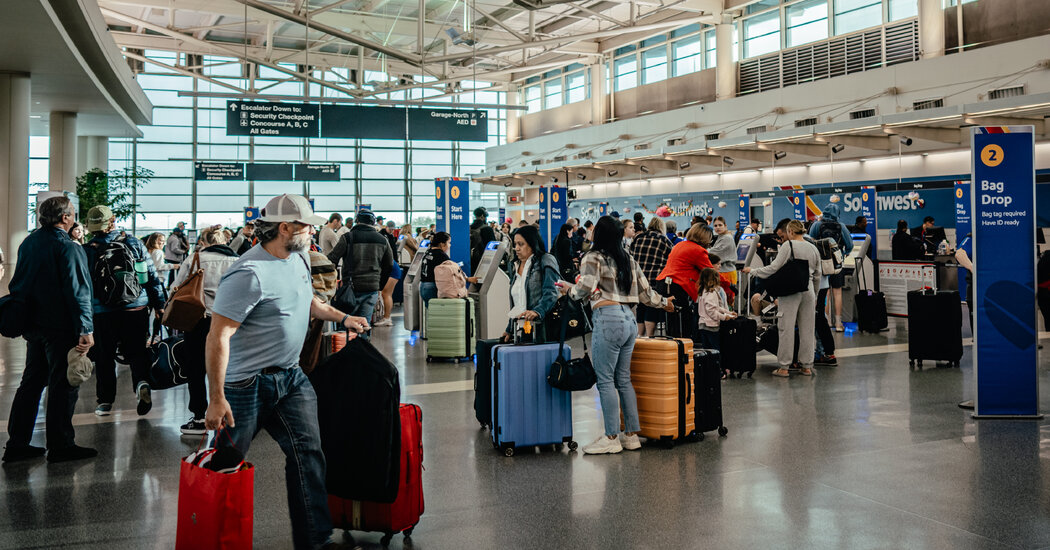The signs inside Terminal B at LaGuardia Airport told the story on Wednesday morning: “Real ID, Enhanced, Passport” with an arrow pointing to the right, and “All Others” with an arrow pointing to the left.
After years of warnings and postponements, “all others” are no longer enough to make it past airport security checkpoints. Travelers are now required to flash a federally compliant Real ID, a passport or another approved form of identification to board domestic flights.
Deadline day started off calmly at LaGuardia, with many passengers arriving up to three hours early, heeding warnings of delays or complications from the Real ID rollout. A large number of Transportation Security Administration employees, airport staff and police officers flanked the security entrance, advising travelers to prepare their IDs.
Arthur Perlman, 61, a former teacher from Queens who described himself as “slightly worried,” came four hours early for his flight to Texas. He had recently gotten a state ID card and presumed it was a Real ID.
But it had neither a star nor an American flag, meaning it was not compliant. “A week ago, I thought about it and went, ‘Oh my God!’” he said. “I did a reality check.”
He briefly panicked, until he learned that a passport is also valid. He had brought that to LaGuardia.
Real ID enforcement comes after 15 years of delays driven by states’ concerns over privacy and steep costs as well as the Covid-19 pandemic. Despite all the warnings and postponed deadlines, the government has still struggled to persuade people to get Real IDs.
States reported varying rates of Real ID compliance ahead of Wednesday’s deadline. In California, it was more than half of all driver’s licenses or ID cards. In Pennsylvania, it was 28 percent.
Travelers also received mixed messages about what to expect at airport security checkpoints when the deadline arrived. While the Transportation Security Administration repeatedly stated that full enforcement would begin on Wednesday, Kristi Noem, the secretary of homeland security, said on Tuesday that travelers who didn’t have a Real ID-compliant document would still be allowed to fly, after additional screening.
At Chicago Midway International Airport, Anthony Harris, a 19-year-old from Chicago who had just completed his freshman year at Hampton University in Virginia, flew home early Wednesday morning without a Real ID.
Mr. Harris, who had pulled an all-nighter to make his 5:45 a.m. flight, said he was not aware of the Real ID deadline when he arrived at the airport at 4 a.m.
“It was out of sight and out of mind. It had been a while since I’ve gone to the airport, so when I got there, I saw the signs and was like, ‘Oh, it is May 7,” he said.
He was allowed through security after going through extra screening but, he said, a T.S.A. agent gave him a notice warning, “The ID you presented is NOT Real ID-compliant.”
Inside busy Terminal C at Newark Liberty International Airport, where equipment failures and air traffic control staffing issues caused more than a week of heavy delays, security lines were moving fairly quickly, with an average wait time of 16 minutes early Wednesday, and no apparent separate line for travelers whose documents were not compliant with Real ID.
Several travelers said they were more concerned over the news that the air traffic controllers who coordinate planes at Newark had briefly lost contact with planes last week, prompting some of the controllers to take trauma leave from work.
“It’s not so much the delays; it was the safety,” said Marty Springer, a New Jersey resident who was flying to San Francisco using his passport. He had not yet been able to obtain a Real ID. New Jersey has one of the lowest Real ID rates in the country, with just around 17 percent of IDs reportedly compliant as of last week.
The Port Authority of New York and New Jersey, which operates Newark, LaGuardia and Kennedy International, said it had increased staffing and worked to increase public awareness of the deadline. “The Port Authority has been working closely with T.S.A., our terminal operators and all airport stakeholders to ensure as smooth a transition as possible as the federal government begins requiring Real ID at T.S.A. checkpoints,” James Allen, the agency’s chief communications officer, said in a statement.
Demand for Real IDs has surged as the deadline loomed, leading to long lines and frustration. On Tuesday, at the Real ID Supercenter in downtown Chicago, Juanita Yost, 53, was waiting to apply with two of her grown children.
Ms. Yost, a nurse, said she was going on vacation in a few weeks, and her daughter, a college student, was planning to fly to Minnesota soon.
It was their third attempt to get Real IDs. They had previously been turned away for not having the required documents. “Yesterday was freezing, and we got here at 9 o’clock in the morning and didn’t get in until almost 1 p.m.,” Ms. Yost said. “They did not communicate anything well.”
Finally, after about four hours, they had completed the application process, just before the center closed for the day. The only catch? Their new cards should take about two weeks to arrive in the mail.
Christine Chung and Nate Schweber reported from LaGuardia Airport, Michael Levenson from Newark Liberty International Airport, and Robert Chiarito from Chicago Midway International Airport.











